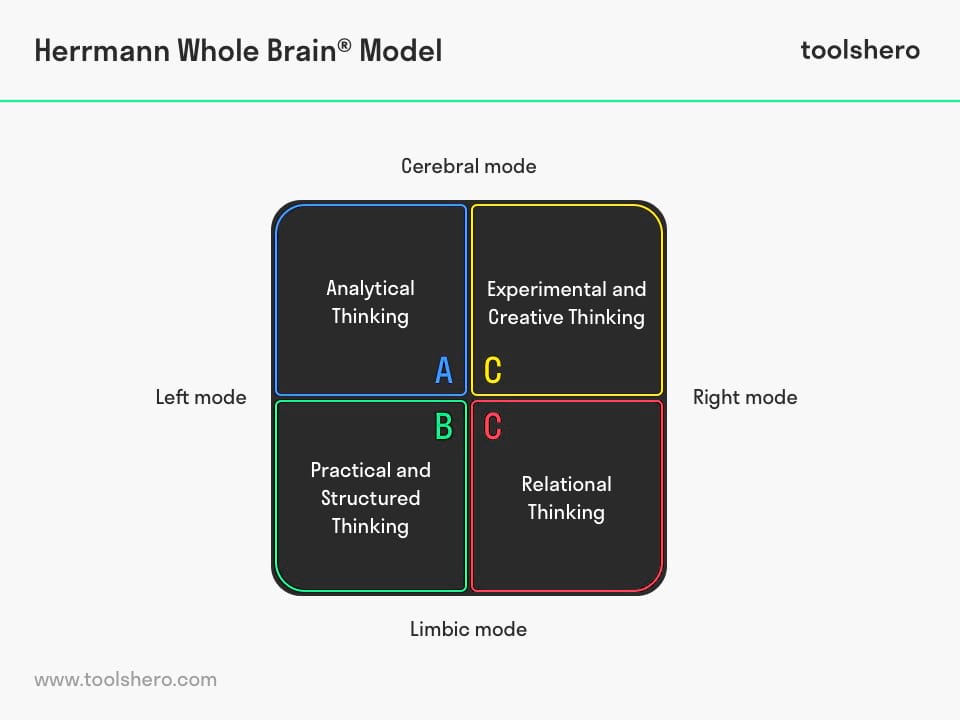Herrmann Whole Brain Model

Herrmann Whole Brain Model: this article describes the Herrmann Whole Brain Model ®, developed by Ned Herrmann in a practical way. This article contains a general definition of the model, different styles and a comparison with other models. After reading you will understand the basics of this model for thinking preferences. Enjoy reading!
What is the Herrmann Whole Brain Model?
The American brain researcher Ned Herrmann developed the patented HBDI model, which stands for Herrmann Brain Dominance Instrument®. Directly related to this is the, also patented, Whole Brain Technology Model®.
Both are inextricably linked. Hermann developed the HBDI on the basis of a large diversity of human behavioural analyses. It provides an overview of the different thinking styles that people usually have, use, and apply. This is also referred to as the thinking preference profile, which is further elaborated in the Hermann Whole Brain model.
In addition to thinking styles, every person has a certain thinking preference. This can be determined using the Herrmann Whole Brain Model.
These thinking preference may change according to one’s phase of life, emotional experiences, insights, education, and other factors.
Each person has access to all four thinking styles. Despite a specific thinking preference, the other thinking styles are also used to varying degrees. In daily life, different situations arise that require different ways of thinking at different times.
Herrmann Whole Brain Model and the HBDI Profile
The HBDI model and the associated Whole Brain Technology model are not tests. After all, it’s not possible to give correct or incorrect answers. Instead, it is about human functioning. The models do not measure a certain degree of intelligence, skills, or competencies either.
Every HBDI profile provides insight into the thinking preference at that moment in time. The final profile prefers a certain way of thinking, learning, communicating, and decision-making. It provides insight into the fact that every person has different interests and the reasons why not everyone communicates in the same way.
People simply have different ways of observing, recording information, making decisions, and solving problems.
When someone understands their own thinking preference within the Herrmann Whole Brain Model, there will be an opportunity for improved communication with their environment and other aspects of personal and interpersonal development.
Threefold Division of the Human Brain
Physiologically speaking, the human brain is made up of three layers: the conative, affective, and cognitive part.
- The conative part is located in the reptile brain. This is the centre of human instinct and where the flight-or-flight reaction takes place. The latter refers to the defence mechanism that occurs in humans and animals when there is an imminent danger. The reaction starts with intense anxiety and stress, and is also referred to as the Flight, Flight, Freeze Response.
- The affective part is located in the limbic brain, which is responsible for our emotions.
- The cognitive part is located in the cortex, especially the neocortex, where the centre of our thinking and knowledge is located.
The Herrmann Whole Brain model uses the conative reptile brain and affective limbic brain. He then combines this division with the one between the left and right brain hemisphere. In the left hemisphere is the logical, analytical, and rational part of human thinking. The right hemisphere includes everything related to intuitive, holistic, and imaginary thinking.
Herrmann Whole Brain Model: Four thinking styles
Every person has the ability to handle situations in different ways. The Hermann Whole Brain model groups the thinking styles into four quadrants: A, B, C, and D. The model is based on a metaphorical model of the brain, with the left and right hemisphere, as well as the and limbic and reptile brain.
In the Herrmann Whole Brain Model, the thinking styles are shown in four different colours and identified as follows:

Figure 1 – Hermann Whole Brain Model styles
Style A: Analytical Thinking (blue area)
The people in this area of the Herrmann Whole Brain Model have a preference for analytical thinking and excel at solving mathematical, numerical, and technical problems in a logical way. They are critical, focus on quantitative data, and assess ideas based on collected facts.
They also want to know what criteria they are dealing with and whether there are any procedures that they should follow.
Style B: Practical and Structured Thinking (green area)
Here, we are talking about the real organisational talents, who work primarily in a controlled, conservative, and planned manner. They can work in a very detailed, structured, and precise way and preferably search for solutions to problems step-by-step.
They are able to set up and elaborate work processes very well, and—due to their planned and structured working method—excel at implementing them.
Style C: Relational Thinking (red area)
These persons can communicate, reason, and convince others very well. They find interpersonal contact with others very important and have a kinaesthetic (sensitive) attitude. They are very empathetic and listen to the ideas and opinions of others. These thinkers are also spiritually minded and find pleasure in the search for the personal meaning of information.
Style D: Experimental and Creative Thinking (yellow area)
The people within this area of the Herrmann Whole Brain Model are imaginative and artistic people who have a conceptual brain.
They have a visual, holistic, intuitive, and innovative approach and are happy to take the initiative. In their eyes, problems can always be solved in one way or another and they enjoy challenges. They focus on the long term in particular.
Hermann Whole Brain model in comparison with Other Models
The Hermann Whole Brain model describes people’s thinking preferences and is a cognitive style measurement. It provides insight into everyone’s own ways of perception. If one is able to understand this, people will be better able to understand the people around them.
The Hermann Whole Brain model is often compared to psychological tests such as the Myers-Briggs Type Indicator (MBTI), a system to classify the differences in people’s personalities.
It also corresponds to a so-called DISC assessment, where people’s preferences become apparent in terms of Dominance, Influence, Steadiness, and Conscientiousness.
These four categories are also displayed in the same colours as those of the Hermann Whole Brain model.
Herrmann Whole Brain Model and the HBDI questionnaire
The individual HBDI assessment that is linked to the model demonstrates the dominances of a certain person’s brain functioning.
By means of an (online) questionnaire of 120 questions, a thinking profile emerges that indicates which activities someone prefers. In this model, multiple styles may be dominant. For example, it may well happen that someone is stronger on the analytical and practical thinking styles, but weaker on the relational and experimental styles.
The final scores of the questionnaire provide insight into someone’s thinking preferences. The Herrmann Whole Brain model can be used to identify both the thinking styles of individuals as well as organisations.
It’s Your Turn
What do you think? What is your experience with the Herrmann Whole Brain Model? Do you recognize the practical explanation above or do you have additions? Are you curious about your HBDI profile?
Share your experience and knowledge in the comments box below.
More information
- Herrmann, N. (1991). The creative brain. The Journal of Creative Behavior>, 25(4), 275-295.
- Herrmann, N. (1999). The theory behind the HBDI and Whole Brain technology. Better results through better thinking.
- Herrmann, N., & Herrmann-Nehdi, A. (2015). The Whole Brain business book: Unlocking the power of whole brain thinking in organizations, teams, and individuals. McGraw Hill Professional.
How to cite this article:
Mulder, P. (2019). Herrmann Whole Brain Model. Retrieved [insert date] from Toolshero: https://www.toolshero.com/psychology/herrmann-whole-brain-model/
Original publication date: 08/04/2019 | Last update: 11/08/2023
Add a link to this page on your website:
<a href=”https://www.toolshero.com/psychology/herrmann-whole-brain-model/”>Toolshero: Herrmann Whole Brain Model</a>












